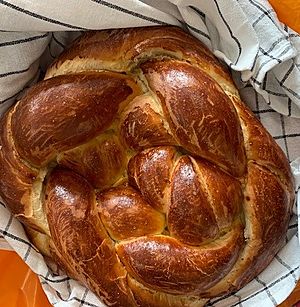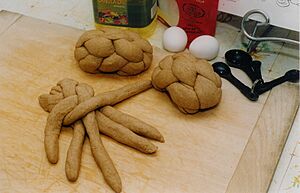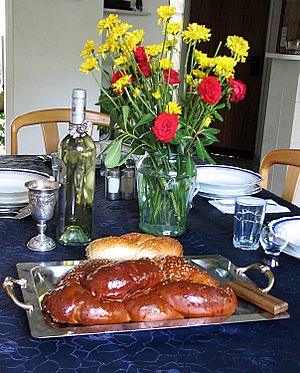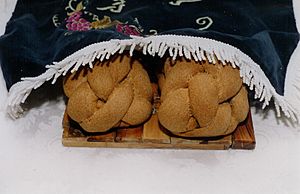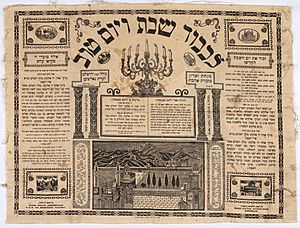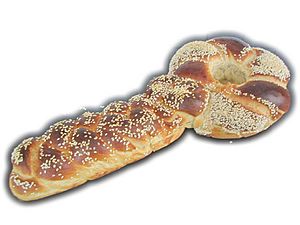Challah facts for kids
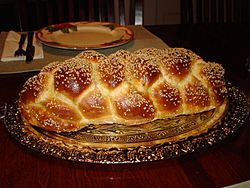
Challah sprinkled with sesame seeds
|
|
| Alternative names | Hallah, khala, khale, chałka, kitke, berkhes, barches, bukhte, dacher, koylatch, koilitsh, shtritsl |
|---|---|
| Type | Bread |
| Main ingredients | Eggs, fine white flour, water, yeast, sugar and salt |
Challah (pronounced HAH-luh) is a special braided bread. It comes from Ashkenazi Jewish traditions. People usually eat challah on special days like Shabbat (the Jewish day of rest) and other major Jewish holidays. However, it is not eaten during Passover.
A small part of the challah dough is traditionally set aside as an offering. This practice is very old. The word "challah" itself comes from the Bible. It first referred to this dough offering. You can find similar braided breads in Central and Eastern Europe. Examples include kalach and vánočka.
Contents
What's in a Name?
The word challah in ancient Hebrew meant a type of loaf or cake. In Jewish religious teachings, challah often means the small piece of dough that must be separated before baking. This piece was traditionally given to a Kohen (a Jewish priest). The Bible commands this practice, calling the separated dough "challah."
This tradition is sometimes called separating challah. The bread made from the rest of the dough is also called challah. This rule applies to any large batch of bread dough. It's especially common when baking for Shabbat or holidays. This is because separating challah is only needed for big batches of dough.
Other Names for Challah
Challah has many different names depending on the region. In Poland, it's known as chałka. In Ukraine, it's called kolach or khala. In Belarus and Russia, it's also called khala.
Historian Judy Batalion notes that the braided challah is a holy symbol for the Jewish Sabbath. She also points out that it's similar to Polish chałka and Ukrainian kolach. It's hard to say which version came first.
Jewish communities in different parts of Europe used other names for this bread. Some of these names are khale, berkhes, barches, bukhte, dacher, kitke, koylatch, koilitsh, or shtritsl. Some of these names, like kitke in South Africa, are still used today.
The name koylatch is similar to names of braided breads in other European cultures. These breads are also eaten on special occasions. Examples include the Russian kalach, Serbian kolač, Ukrainian kolach, Hungarian kalács, and Romanian colac. These names come from an old Slavic word meaning "circle" or "wheel." This refers to the round shape of some loaves.
In the Middle East, Shabbat breads were often just called by the local word for bread. For example, noon in Farsi or khubz in Arabic.
How Challah is Made
Most traditional challah recipes use several eggs, fine white flour, water, sugar, yeast, oil, and salt. There is also "water challah," which is made without eggs. This type of challah is good for people who follow vegan diets.
Modern recipes might use whole wheat, oat, or spelt flour instead of white flour. They might also use honey or molasses instead of sugar.
Some Jewish traditions say that if bread has too much sugar, it becomes like a cake. This would change the blessing said over the bread. This would make it unsuitable for use during the Kiddush (a special blessing) for Shabbat. While braided breads exist in Sephardic cooking, they are usually different from challah. They are often regional breads like çörek.
Egg challah sometimes has raisins or saffron added. After the dough rises the first time, it's rolled into long ropes. These ropes are then braided. Different regions have unique braiding styles. For example, some make fish or hand shapes. Round challahs are also common for certain times of the year.
Poppy or sesame seeds are often added to the dough or sprinkled on top. Before baking, both egg and water challah are usually brushed with an egg wash. This gives them a shiny, golden crust.
Challah is usually pareve. This means it contains no dairy or meat. This is important for following Kosher food laws. Other rich European breads, like brioche, often contain butter or milk.
In Israel, Shabbat breads are very diverse. They reflect the traditions of Jewish communities from many different countries. These breads might include eggs or olive oil in the dough. They also use water, sugar, yeast, salt, honey, and raisins. They can be topped with sesame or other seeds.
Challah's Special Meaning
Jewish tradition says that the three Sabbath meals and two holiday meals should each start with two full loaves of bread. This "double loaf" is called lechem mishneh in Hebrew. It reminds people of the manna that fell from the sky when the Israelites were in the desert. The manna did not fall on Sabbath or holidays. Instead, a double portion would fall the day before to last for both days.
In some traditions, each challah loaf is braided with six strands of dough. Together, the two loaves have twelve strands. This reminds people of the twelve loaves of showbread that were offered in the ancient Temple. Other common numbers of strands are three, five, and seven. Sometimes, twelve strands are used, and this is called a "Twelve Tribes" challah.
Shabbat Meal Steps

It is a custom to start the Sabbath and holiday meals with these steps:
- The challah is covered, usually with a special challah cover cloth. This allows the blessing over wine (Kiddush) to be said first.
- Kiddush is recited over a cup of wine.
- Everyone washes their hands in a special way before eating bread. People usually don't talk between washing hands and eating the bread.
- The challah cover is removed.
- The two loaves are held up together.
- The person leading the meal says a blessing over the bread. It means: "Blessed are you Lord our God, King of the Universe, who brings forth bread from the earth."
- The bread is sliced or torn and salted. Pieces are then given to everyone at the meal to eat.
The exact way this is done can vary. Some people dip the bread in salt before the blessing. Others say the blessing, cut the challah, and then dip the pieces in salt. Some communities also make a small cut in the bread with a knife.
Why Salt?
Salting challah is an important part of the meal. Some traditions dip the challah in salt, others sprinkle salt on it, or just have salt on the table.
The Torah (Jewish holy texts) says that offerings to God in the Temple must include salt. After the Temple was destroyed, Jewish teachers said that a meal table is like the Temple altar. So, a blessing over food should be said with salt on the table.
For these teachers, a meal without salt was not a complete meal. Also, in the Torah, salt stands for the lasting promise between God and the Jewish people. Salt doesn't spoil, showing that this bond is forever.
Special Challahs
Rosh Hashanah Challah
On Rosh Hashanah, the Jewish New Year, challah is often shaped into a circle. This shape symbolizes the cycle of the year. Sometimes, raisins are baked into the dough. Some people continue to eat round challah until the holiday of Sukkot. In North Africa, many Jews bake their challah in a "turban challah" shape all year.
Sometimes, the top of the challah is brushed with honey. This symbolizes a "sweet new year." Some traditions use honey instead of salt with challah on Rosh Hashanah. This can continue through the Sukkot holiday.
Key Challah (Shlissel Challah)
For a special Shabbat after Passover, some Ashkenazi Jews bake shlissel challah (key challah). This is seen as a good sign for earning a living. Some people press a key shape onto the challah before baking. Others place a key-shaped piece of dough on top. Some even bake a real key inside the challah!
This custom is mentioned in a book from the 1800s. It calls key challah "an ancient custom." The book explains that after leaving the desert, the Israelites had to start working for their food. The key on the challah is like a prayer to God to help them find ways to earn a living.
Similar Breads Around the World
Many other cultures have braided, egg-rich breads that are similar to challah.
- The Polish chałka is similar but often sweeter.
- The Czech and Slovak vánočka is very similar and traditionally eaten at Christmas.
- In Bulgaria and Romania, there is a bread called cozonac.
- Tsoureki bread is popular in Armenian, Greek, and Turkish cooking.
- A sweet bread called milibrod is eaten during Orthodox Easter in Macedonia.
- Zopf is a similar bread from Germany, Austria, and Switzerland. A sweeter version is called Hefezopf.
- In Finland, pulla is a small braided pastry flavored with cardamom.
Unlike challah, which is usually pareve (no dairy or meat), many of these similar breads contain butter and milk.
See also
 In Spanish: Jalá para niños
In Spanish: Jalá para niños


